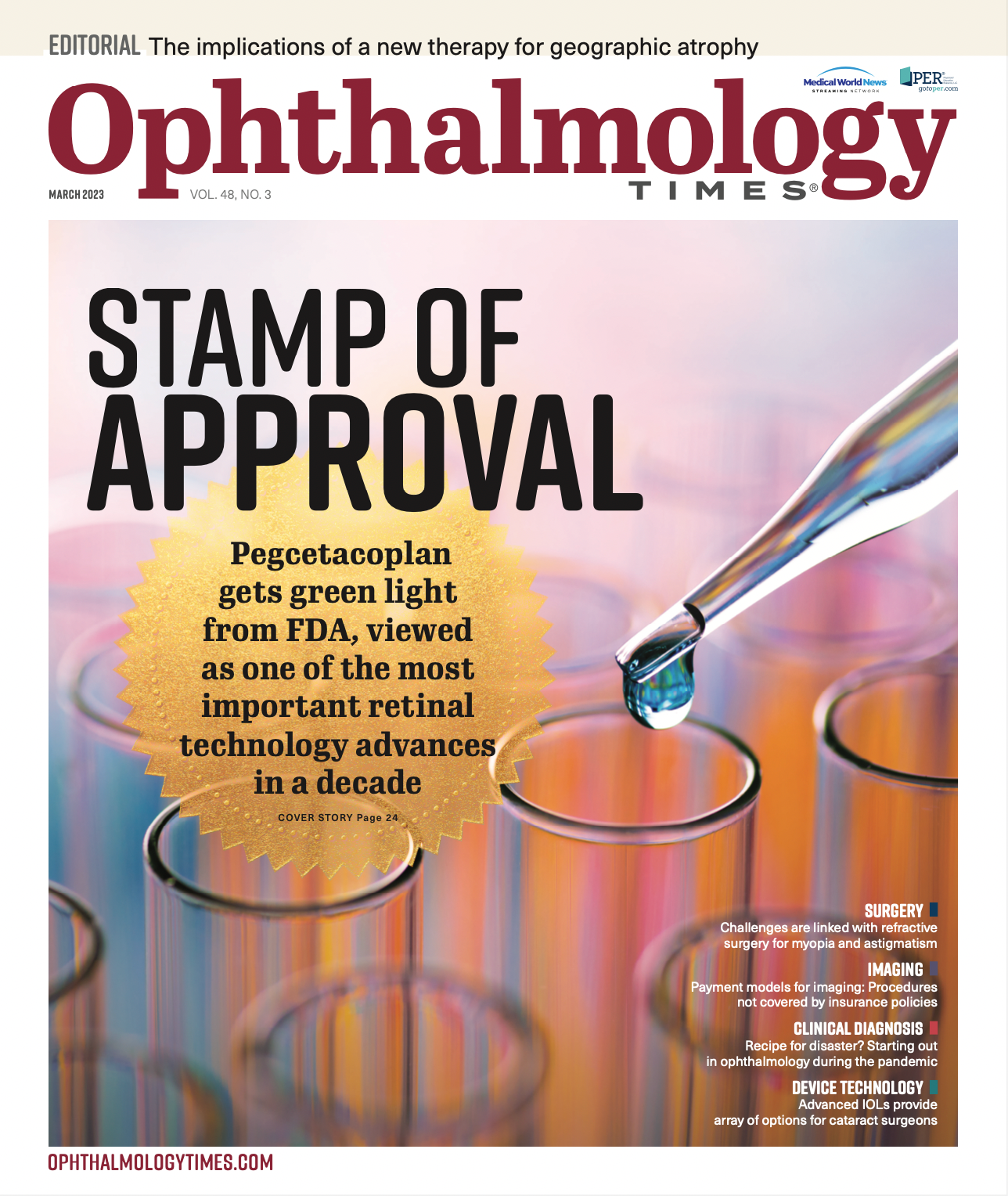Publication
Article
Digital Edition
Next-generation MGD: Patients in their 20s, 30s offer new perspectives
Author(s):
Long-term screen users and contact lens wearers in group face challenges.
Watson says that virtually all my patients in their 20s and 30s report they use screens 8 or more hours every day.(Image credit: AdobeStock/Delmaine D)

The best meibography images I see at Watson Dry Eye Center are for patients in their 70s and 80s. In comparison, imaging for patients in their 20s and 30s often reveals short, missing, or clogged glands.
How is this possible when younger people have more robust, resilient anatomy? From my experience, the disparity stems from big differences in lifestyle—namely, hours spent staring at device screens.
The earlier onset of meibomian gland dysfunction (MGD) has been a major topic of discussion among dry eye specialists, particularly the last 5 years. In a recent study, 42% of kids aged 4 to 17 years showed some evidence of meibomian gland atrophy.1 We do not have direct evidence that screen time is the culprit, but because many children spend long hours using screens, blinking less frequently and completely, we think screen time may contribute to the problem. Ten years later, that teenager is coming to see me.
Here are some insights from my experience with the unique complaints, presentations, challenges, and goals of patients with MGD in their 20s and 30s.
Eye care concerns of a new generation
In the past, most of my patients with dry eye were 50-plus, seeking help for their symptoms. They viewed dry eye’s eyelid redness and tired appearance as a normal part of aging. Now I see patients in their 20s and 30s whose screen time is endless, and their ability to function at an efficient level diminishes as the day goes on. Many of them have already spent a decade in contact lenses, and now they cannot wear them anymore. Others have had refractive surgery, which disrupts the corneal nerves. Many of them want to know if I can do something about their eyelid redness and tired appearance—problems that embarrass them every day as they sit through one Zoom meeting after another.
Imaging often shows that the meibomian glands are obstructed, dilated, tortuous, and shortened. Rosacea often first appears when people are in their late 20s and early 30s, so it can be another causative factor for the dry eye.
Meibography images of the meibomian gland. (Images courtesy of Susan Watson, MD)

With all new patients, I start with a 45-minute telehealth visit, during which I get the opportunity to hear their stories and observe their blinking, habits, and mask-free appearance in a comfortable setting. Young people take particularly well to this approach because they’re so accustomed to using FaceTime and Zoom. By the time the call is done, I have a lot of information about the patient’s history, signs, and symptoms— from a childhood history of styes to concern that their tired, red eyes are affecting their work prospects. Virtually all my patients in their 20s and 30s report they use screens 8 or more hours every day. All these factors inform the exam and treatment decisions.
Detailed diagnosis and robust treatment
To get as much information as I can about a patient with dry eye disease, I do a thorough exam and battery of diagnostic tests. I use the LipiView II (Johnson & Johnson Vision) for meibography and to measure lipid layer thickness and determine whether blinking is complete.
The Keratograph 5M (Oculus) and Crystal TEAR Report (Oculus) give me tear film break-up time, lissamine green corneal staining, redness scale, and other tear film data. I also express the glands, check corneal nerve sensation, measure ω-3 levels, do a detailed slit lamp exam, and epilate lashes to look for debris and demodex under the microscope.
When I go over the results with young patients, I explain that we can’t cure dry eye but that we have good therapies. If we work hard in the first year, we can make a huge impact on how they look and feel, as well as their ability to wear contact lenses and enjoy their favorite activities.
Because young patients will rely on their meibomian glands for perhaps another 70 years, we need to treat aggressively and do all we can to preserve the anatomy and restore function. I follow the best evidence-based science for therapy. There is no standard treatment for the varied factors contributing to MGD, but I usually emphasize in-office treatments.
A cornerstone of in-office treatment is OptiLight (Lumenis Ltd) light-based therapy, which restores meibomian gland function (thus enhancing the tear film), decreases the level of inflammation (an underlying cause of MGD), and reduces bacterial load and Demodex.2-8
Other in-office therapies can be complementary to OptiLight. For example, patients with accumulated lid scurf benefit from eyelid clean- ing with BlephEx (BlephEx). Some patients with MGD who have a significant number of glands blocked with hard, inspissated meibum can benefit from LipiFlow (Johnson & Johnson Vision) thermal pulsation or TempSure Envi (Cynosure) radiofrequency treatment.
At-home care such as omega -3 supplements, immunomodulator drops, lid hygiene, and good artificial tears are supportive adjuncts, but patients can do less treatment at home when they have effective in-office treatment. By matching the right treatments to the right patients, we can avoid gland loss and achieve a more stable tear film that functions properly.
CASE: 28-year-old Zoom user with MGD
I recently saw a 28-year-old woman with MGD. She wore contact lenses and estimated that she spent 12 hours a day using screen devices. She had rosacea, and her eyelid margins were red. She told me that she was depressed about how she looked on the Zoom calls she was required to participate in every day for work. She’d been using more eye makeup for these calls to try to appear more bright-eyed and less red and “squinty.” The patient’s meibography grade was 4 oculus unitas; her redness score was 1.9 OD/2.0 OS; and noninvasive Keratograph tear breakup time on the initial assessment was “too short” oculus unitas, indicating severe dry eye.
The patient had 4 OptiLight treatment sessions to bring the inflammation under control and improve her meibomian glands. BlephEx was an important addition because I was concerned about excessive lid scurf and bacteria, made worse by eye makeup. Because she
had a significant number of blocked glands,
I complemented OptiLight with LipiFlow. We talked about the importance of using safer eye makeup (Éyes Are The Story) in the future and not putting eyeliner inside the eyelid.
After the treatments, the patient’s noninvasive Keratograph tear breakup time was 8 seconds OD and 9 seconds OS, and her redness score improved to 0.6 OD/0.8 OS.
When I saw the patient 6 weeks after treatment, her eyes were wide open, and she was smiling. She told me, “I looked at myself in the mirror this morning and thought, ‘Wow, look at my eyes!’” We looked at the improvement of her gland structure on meibography images, as well as how her Keratograph 5M images showed she’d been keeping her eyelids very clean at home.
The patient told me she was back in her contact lenses. Her eyes were no longer affecting her work and activities. She wasn’t depressed about her appearance or frustrated with her eyes anymore.
I hope stories like this one encourage more people to recognize and treat MGD in young people because we can make a big differ- ence in their lives. You do not need all the gadgets—just a validated questionnaire and awareness of telltale signs at the slit lamp. We can take advantage of every opportunity to help patients in their 20s and 30s improve their lives and preserve their meibomian glands for the future.
Susan Watson, MD
P: 252-231-0424
Watson is the founder and owner of Watson Dry Eye Center in Raleigh, North Carolina. She is a key opinion leader for Lumenis Ltd.
References:
Gupta PK, Stevens MN, Kashyap N, Priestley
Y. Prevalence of meibomian gland atrophy in a pediatric population. Cornea. 2018;37(4):426-430. doi:10.1097/ICO.0000000000001476Liu R, Rong B, Tu P, et al. Analysis of cytokine levels in tears and clinical correlations after intense pulsed light treating meibomian gland dysfunction. Am J Ophthalmol. 2017;183:81-90. doi:10.1016/j. ajo.2017.08.021
Yin Y, Liu N, Gong L, Song N. Changes in the mei- bomian gland after exposure to intense pulsed light in meibomian gland dysfunction (MGD) patients. Curr Eye Res. 2018;43(3):308-313. doi:10.1080/0271 3683.2017.1406525
Kassir R, Kolluru A, Kassir M. Intense pulsed light for the treatment of rosacea and telangiectasias. J Cosmet Laser Ther. 2011;13(5):216-222. doi:10.310 9/14764172.2011.613480
Papageorgiou P, Clayton W, Norwood S, Chopra S, Rustin M. Treatment of rosacea with intense pulsed light: significant improvement and long-last- ing results. Br J Dermatol. 2008;159(3):628-632. doi:10.1111/j.1365-2133.2008.08702.x
Prieto VG, Sadick NS, Lloreta J, Nicholson J, Shea CR. Effects of intense pulsed light on sun-damaged human skin, routine, and ultrastructural analysis. Lasers Surg Med. 2002;30(2):82-85. doi:10.1002/ lsm.10042
Dell SJ, Gaster RN, Barbarino SC, Cunningham DN. Prospective evaluation of intense pulsed light and meibomian gland expression efficacy on re- lieving signs and symptoms of dry eye disease due to meibomian gland dysfunction. Clin Ophthalmol. 2017;11:817-827. doi:10.2147/OPTH.S130706
Toyos R, McGill W, Briscoe D. Intense pulsed light treatment for dry eye disease due to meibo- mian gland dysfunction; a 3-year retrospective study. Photomed Laser Surg. 2015;33(1):41-46. doi:10.1089/pho.2014.3819

Newsletter
Don’t miss out—get Ophthalmology Times updates on the latest clinical advancements and expert interviews, straight to your inbox.




